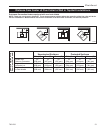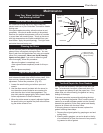
19
Dutchwest
7001219
Break-in Fires
If your stove is new or has new cast iron replacement
parts, “season” the new cast iron with a few break-in
fires. Follow Steps 1-3 below. Then let the fire burn
out. Do not close the damper. Maintain a small, but
not smoky, fire by adjusting the primary air control.
After the break-in fires, continue with Step 4.
The stove’s paint and cement will emit a slight odor
as these materials cure during the first few fires. You
may wish to provide extra ventilation near the stove by
partially opening a door or window when the odor is
present.
Lighting the Fire
Step 1. Open the stove damper. Fully open both the
primary air control and the front air control.
Step 2. Lay some crumpled newspapers in the stove.
Place six or eight finger-width size pieces of dry kin-
dling on the paper. On the kindling, lay two or three
larger sticks of split dry wood approximately 1-2” (25-50
mm) thick.
DO NOT USE CHEMICALS OR FLUIDS TO START
THE FIRE. DO NOT BURN GARBAGE OR FLAM-
MABLE FLUIDS SUCH AS GASOLINE, NAPTHA, OR
ENGINE OIL.
Also, never use gasoline-type lantern fuel, kerosene,
charcoal lighter fluid, or similar liquids to start or
“freshen up” a fire in this heater. Keep all such liquids
well away from the heater while it is in use.
Step 3. Light the newspaper and close the door. The
fire should be well-established within 10-15 minutes.
You may gradually build it up by adding a few sticks at
a time of a progressively larger size. Continue to build
the fire until a live coal bed begins to form.
NOTE: An especially large, outdoor, or cold chimney
may need to be “primed,” or warmed up, before it will
draw sufficiently to start a fire. If this is the case, roll up
a couple pieces of newspaper, place them on top of the
kindling and toward the back of the stove, light them,
and close the doors. This should heat the chimney
enough to initiate a draft.
Once the draft is established, open the front door and
light the rest of the fuel from the bottom. Do not light
the main bed of fuel until the chimney begins drawing.
Repeat the procedure as often as necessary if the initial
attempt is unsuccessful.
Step 4. After a lively fire has been established, (ap-
prox. 30 minutes) close the stove damper.
Step 5. Close the primary air control to a medium low
setting. The fire volume will diminish immediately, but
the stove will continue to warm up. Maintain control of
the fire using the primary air control. Reduce the setting
for a smaller fire, increase the setting for a hotter, more
intense fire. Refer back to the air control settings chart
on Page 19.
DO NOT OVERFIRE THIS HEATER. Overfiring may
cause a house fire, or can result in permanent damage
to the stove. If a part of the stove or the chimney con-
nector glows, you are overfiring.
Reloading and Reviving the Fire
Open the stove damper and wait at least fifteen sec-
onds for the draft to increase. Open the door slowly
and add the fuel. Split firewood will fill the firebox more
completely than will unsplit wood and will thereby re-
duce the frequency of reloading.
You may find the fire intensity will decrease after reload-
ing, particularly if the loading door is open a long time.
Stimulate the fire by increasing the primary air supply
and leave the stove damper open. Then as soon as the
fire is reestablished, close the damper and reduce the
air supply to prevent over-firing.
Further suggestions...
* If the charcoal bed is relatively thick and your fuel is
well-seasoned, it is possible to add fresh fuel (smaller
pieces first), close the door and damper, and reset the
air control within five minutes.
* When refueling, avoid breaking the charcoal bed into
small pieces. Large pieces of charcoal help the fire
recover quickly.
* The glass will remain cleaner if refueling is done
when the previous load of fuel has burned down to hot,
glowing coals. Use a crumpled piece of dry newspaper
to wipe fly ash buildup off of the glass. Do not use liquid
cleaning agents of any type on hot glass.
Remove Ashes Frequently
Wear heavy stove gloves when removing ashes. Check
the ash compartment before reloading the stove. If the
ashes are close to the top, empty the pan. Before re-
placing the ash pan, clear away any ash that has spilled
over the sides and back of the ash pan.
Empty the ash drawer regularly - typically every one to
three days. The frequency will vary depending on how
hot you run your stove: the hotter the fire, the more
wood you burn, and the faster ash will accumulate.


















